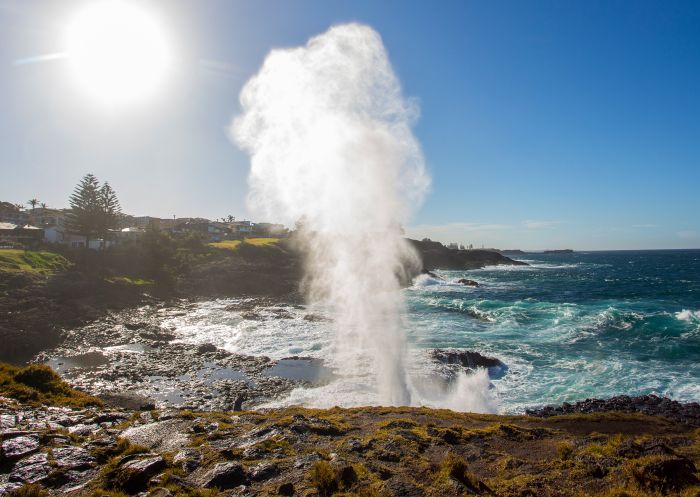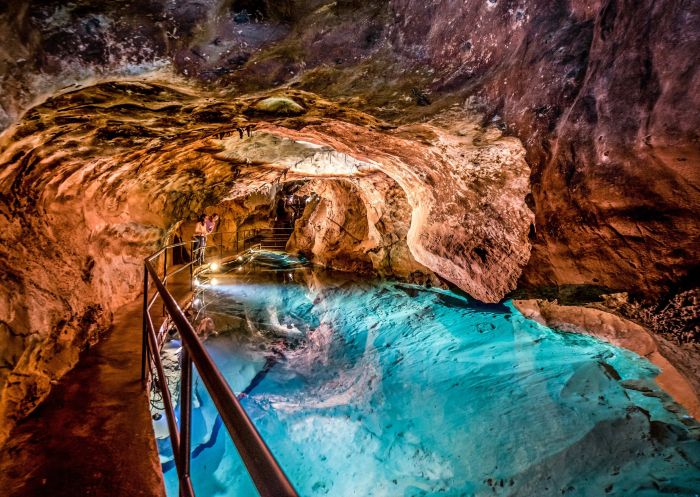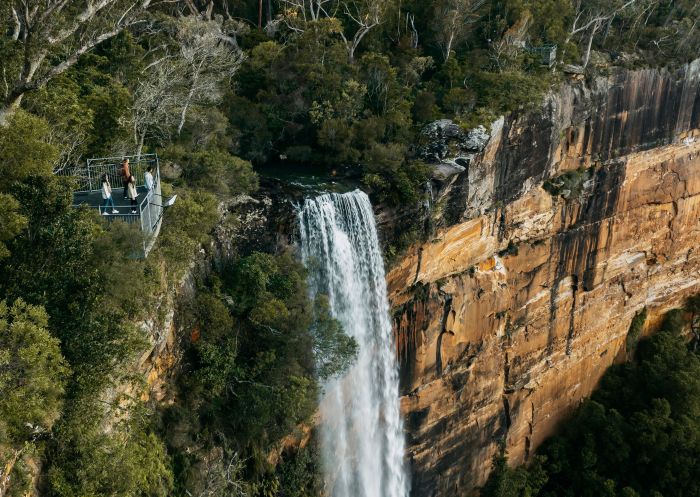

NSW's most iconic natural wonders
Bombo Headland - Credit: Kramer Photography | www.kramer.photography




Destination NSW
Where: Blue Mountains
These three gigantic pillars of rock in the Blue Mountains west of Sydney are truly amazing. They stand sentinel on a rugged finger of land, imposing and beautiful. However, the other attraction here is the backdrop, the seemingly endless expanse of mountains, eucalypt forests and clifftops that blend into the horizon far off in the distance. It’s easy to see why this location has inspired myth and legend since the Gundungurra and Darug people first inhabited the area. Take a selfie from the Echo Point scenic lookout, get a bird’s-eye view on the Scenic World skyway or stand underneath the fourth sister on the Three Sisters walk.

The Three Sisters, Blue Mountains
Where: South Coast
The largest blowhole in the world. That’s an impressive record, and one that’s impossible to truly appreciate until you visit the Kiama Blowhole (located in the coastal town of Kiama, a two-hour drive south of Sydney) and see it for yourself. When the swell is running from the south-east, water is forced through a 2.5m opening in the rock, resulting in a tower of spray some 30m high. This is the awesome power of nature at its mighty best.

Kiama Blowhole, Kiama
Where: Mungo National Park
Need a dose of awesome in your life? Then consider making the trek to Mungo National Park in the state’s far west (about 875km from Sydney) to see the other-worldly Walls of China. The “walls” are towering sandstone and clay dunes riven with channels and ripples carved over thousands of years by the wind. They’re an incredible, almost alien sight in an already amazing place, and they’ll make you feel so wonderfully tiny in comparison.

Mungo National Park, Mungo - Credit: Tyson Mayr
Where: Sydney
Here’s another record-holder: Sydney Harbour, the largest natural harbour in the world. And it truly is a gorgeous and breathtaking expanse, 55 square kilometres of water surrounded by beaches, national parks and some of the world’s most desirable real estate. The best way to appreciate its grandeur is by boat. Take a catered cruise, ride on a majestic tall ship, jump in a jetboat, or hire a yacht and a skipper.

Sailing on Sydney Harbour
Where: Blue Mountains
The vastness of the Jenolan Caves system, just west of the Blue Mountains, is difficult to overstate. There are 40km of underground warrens here, the limestone caves formed over millennia. To visit the caves is to be amazed by what lies beneath: huge open areas where stalactites drip from the ceiling and limestone formations, carved by ancient rivers, abound. This isn’t a church, but most visitors are still stunned into silence by the grandeur.

The Pool of Reflections in the River Cave, within the iconic Jenolan Caves - Credit: Timeless Creations | Jenolan Caves Reserve Trust
Where: South Coast
The unusual basalt columns of Bombo Headland make it feel as though you're walking on the moon. These rock formations are a product of the region's rich mining history and blue metal quarrying in the 1880s and 1900s, along with centuries of exposure to the powerful ocean forces. The area is often featured in television commercials and photo shoots, and is the perfect place to test out your photography skills – especially at sunrise.

Bombo Headland, Kiama Coast Walk
Where: Port Stephens
Picture a block of apartments, 10 storeys tall. Now consider this: the sand dunes at Stockton Bight, on the Worimi Conservation Lands near Port Stephens, are about the same height. Standing in front of these huge mountains of sand is enough to make anyone feel tiny. The dunes are also an adventure lover's playground, with opportunities for 4WD trips, as well as cultural journeys with local Indigenous owners.

Stockton Sand Dunes, Port Stephens
Where: Lake Macquarie
A popular photography spot in Lake Macquarie is the incredible Caves Beach with an intricate network of sea caves, which will have your imagination running wild as you explore the arches and crevices. A great photo opportunity is at golden hour from inside the largest cave looking out to sea.

Caves Beach, Lake Macquarie
Where: Bermagui
Once you glimpse Horse Head Rock, you’ll immediately understand how it came by its name. This distinctive rock formation off the Sapphire Coast near Bermagui not only resembles the neck of a graceful pony but is also historically significant – at more than 500 million years old, it’s one of NSW’s most ancient rock edifices. The attraction is best viewed from the lookout platform accessed along the 1.5km one-way elevated walking track between Camel Rock and Murunna Point.

Horse Head Rock, Bermagui
Where: Southern Highlands
In the Southern Highlands near Nowra, Morton National Park is home to stunning gorges, rainforest and the magnificent Fitzroy Falls. From the visitor’s centre there is a boardwalk with several spots to marvel at the water pouring more than 80m into the valley below. Still chasing waterfalls? Nearby, join a short walking track to see views of Belmore Falls, a powerful plunge waterfall with two drops on the Barrengarry Creek, cascading over 100m.

Fitzroy Falls, Kangaroo Valley
Where: Country NSW
As the sun sets in NSW, a dazzling array of stars is revealed, especially in Central NSW where the landscape tends to be flatter and the skies clearer. NSW is home to Australia’s first Dark Sky Park, Warrumbungle National Park, where the low humidity and high altitude create the perfect place to view the Milky Way galaxy. Australia’s largest optical observatory is located on the outskirts of the park and offers informative daytime tours. For a stargazing experience, book a tour with Donna the Astronomer at Milroy Observatory in Coonabarabran at the foothills of the Warrumbungle Mountains.

The night sky filled with bright stars over the Dark Sky Park, Warrumbungle National Park
Where: The Riverina
The Australian bush has so many amazing colours in its palette: but have you ever seen a huge field of bright yellow that stretches to the horizon? You can experience these seemingly endless golden swathes on the Canola Trail in the Riverina region, about a four-hour drive west of Sydney. In spring, the usually verdant hills explode into a buttery blanket of yellow as the canola fields flower. Bloomin’ magnificent.

Canola Trail, Riverina
Where: Lithgow
Inside a certain tunnel in Wollemi National Park, you’ll find yourself enveloped by silence and complete darkness. Turn your torch off and you’ll see a forest of electric blue orbs sparkling above you in every nook and cranny of the ancient rock: thousands of tiny glow worms – which are actually the larvae of a small fly. For a self-guided exploration of the 400-metre-long Glow Worm Tunnel – which is part of a historical disused railway line near Lithgow – tackle the 6km return Glow Worm Tunnel walking track. Due to the long length of the tunnel, it gets dark enough to see glow worms even during the day.

Glow Worm Tunnel walking track, Wollemi National Park - Credit: Daniel Tran | DPE
Stay connected to Visit NSW for all the latest news, stories, upcoming events and travel inspiration.
All the insider news, tips and inspiration you need to plan your next trip, delivered straight to your inbox.
Sign UpVisitNSW.com is the official tourism site for Destination NSW.
© Copyright 2025 Destination NSW. All rights reserved